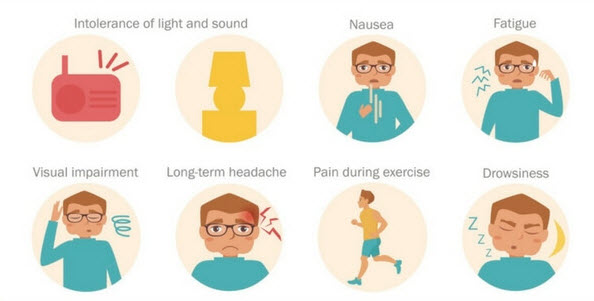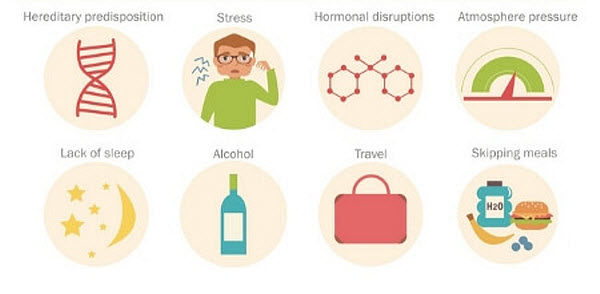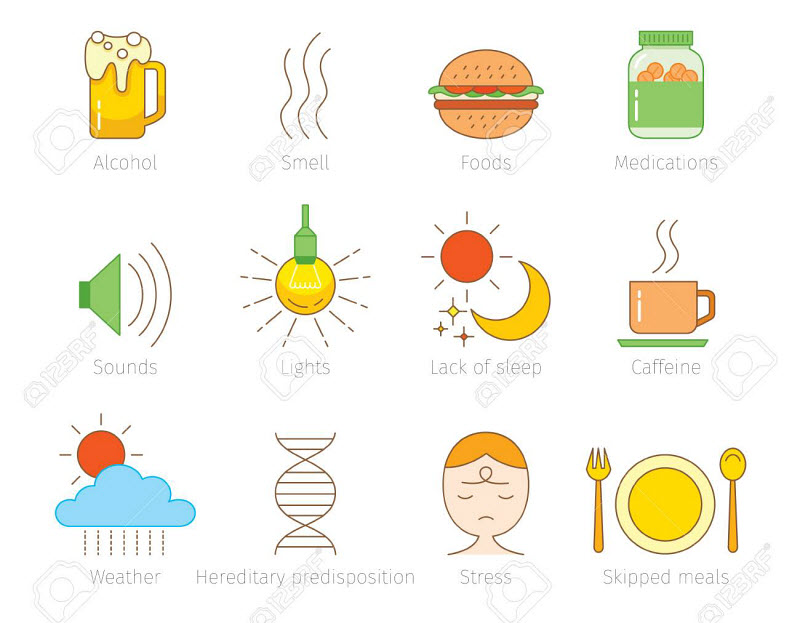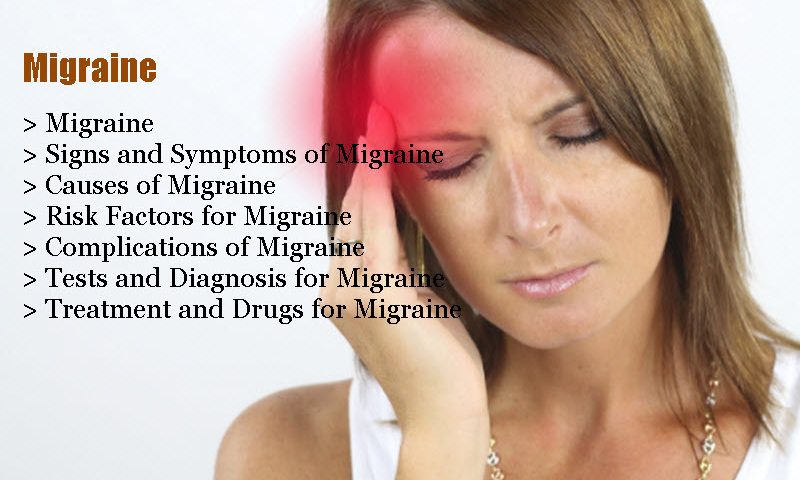This discussion includes the following information related to Migraine:
- Migraine
- Signs and Symptoms of Migraine
- Causes of Migraine
- Risk Factors for Migraine
- Complications of Migraine
- Tests and Diagnosis for Migraine
- Treatment and Drugs for Migraine
Migraine Definition

A migraine headache can cause intense throbbing or a pulsing sensation in one area of the head and is commonly accompanied by nausea, vomiting, and extreme sensitivity to light and sound.
Migraine attacks can cause significant pain for hours to days and be so severe that all you can think about is finding a dark, quiet place to lie down.
Some migraines are preceded or accompanied by sensory warning symptoms (aura), such as flashes of light, blind spots, or tingling in your arm or leg.
Medications can help reduce the frequency and severity of migraines. If treatment hasn’t worked for you in the past, talk to your doctor about trying a different migraine headache medication. The right medicines, combined with self-help remedies and lifestyle changes, may make a big difference.
Signs and Symptoms of Migraine

Migraine headaches often begin in childhood, adolescence or early adulthood. Migraines may progress through four stages, including prodrome, aura, headache and postdrome, though you may not experience all the stages.
Prodrome
One or two days before a migraine, you may notice subtle changes that signify an oncoming migraine, including:
- Constipation
- Depression
- Food cravings
- Hyperactivity
- Irritability
- Neck stiffness
- Uncontrollable yawning
Aura
Aura may occur before or during migraine headaches. Auras are nervous system symptoms that are usually visual disturbances, such as flashes of light. Sometimes auras can also be touching sensations (sensory), movement (motor) or speech (verbal) disturbances.
Most people experience migraine headaches without aura. Each of these symptoms usually begins gradually, builds up over several minutes, and then commonly lasts for 20 to 60 minutes.
Examples of aura include:
- Visual phenomena, such as seeing various shapes, bright spots or flashes of light
- Vision loss
- Pins and needles sensations in an arm or leg
- Speech or language problems (aphasia)
- Less commonly, an aura may be associated with limb weakness (hemiplegic migraine).
Attack
When untreated, a migraine usually lasts from four to 72 hours, but the frequency with which headaches occur varies from person to person. You may have migraines several times a month or much less often.
During a migraine, you may experience the following symptoms:
- Pain on one side or both sides of your head
- Pain that has a pulsating, throbbing quality
- Sensitivity to light, sounds and sometimes smells
- Nausea and vomiting
- Blurred vision
- Lightheadedness, sometimes followed by fainting
Postdrome
The final phase, known as postdrome, occurs after a migraine attack. During this time you may feel drained and washed out, though some people report feeling mildly euphoric.
EMERGENCY CASES Migraine headaches are often undiagnosed and untreated. If you regularly experience signs and symptoms of migraine attacks, keep a record of your attacks and how you treated them. Then make an appointment with your doctor to discuss your headaches. Even if you have a history of headaches, see your doctor if the pattern changes or your headaches suddenly feel different. See your doctor immediately or go to the emergency room if you have any of the following signs and symptoms, which may indicate other, more serious medical problems:
Causes of Migraine

Although much about the cause of migraines isn’t understood, genetics and environmental factors appear to play a role.
Migraines may be caused by changes in the brainstem and its interactions with the trigeminal nerve, a major pain pathway.
Imbalances in brain chemicals — including serotonin, which helps regulate pain in your nervous system — also may be involved. Researchers continue to study the role of serotonin in migraines.
Serotonin levels drop during migraine attacks. This may cause your trigeminal system to release substances called neuropeptides, which travel to your brain’s outer covering (meninges). The result is headache pain.
Migraine Headache Triggers

Whatever the exact mechanism of the headaches, a number of things may trigger them. Common migraine triggers include:
- Hormonal changes in women: Fluctuations in estrogen seem to trigger headaches in many women with known migraines. Women with a history of migraines often report headaches immediately before or during their periods, when they have a major drop in estrogen. Others have an increased tendency to develop migraines during pregnancy or menopause.
- Hormonal medications: such as oral contraceptives and hormone replacement therapy, also may worsen migraines. Some women, however, may find their migraines occur less often when taking these medications.
- Foods: Aged cheeses, salty foods and processed foods may trigger migraines. Skipping meals or fasting also can trigger attacks.
- Food additives: The sweetener aspartame and the preservative monosodium glutamate, found in many foods, may trigger migraines.
- Drinks: Alcohol, especially wine, and highly caffeinated beverages may trigger migraines.
- Stress: Stress at work or home can cause migraines.
- Sensory stimuli: Bright lights and sun glare can induce migraines, as can loud sounds. Unusual smells — including perfume, paint thinner, secondhand smoke and others — can trigger migraines in some people.
- Changes in wake-sleep pattern: Missing sleep or getting too much sleep may trigger migraines in some people, as can jet lag.
- Physical factors: Intense physical exertion, including sexual activity, may provoke migraines.
- Changes in the environment: A change of weather or barometric pressure can prompt a migraine.
- Medications: Oral contraceptives and vasodilators, such as nitroglycerin, can aggravate migraines.



